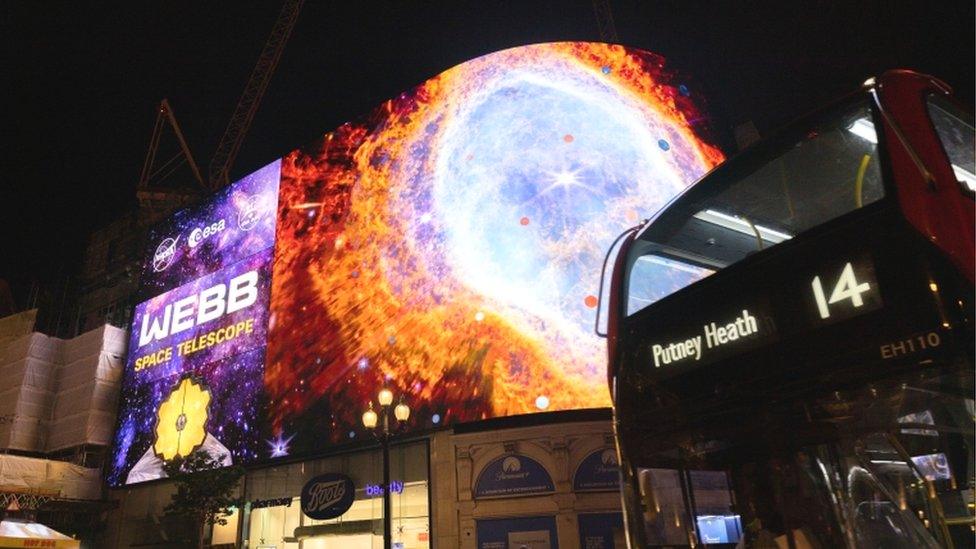James Webb: Nasa releases first images from world's biggest space telescope
- Published
- comments

The new images were even displayed at London's Piccadilly Circus
Nasa has released the first full-colour images taken by the James Webb space telescope!
The pictures reveal detailed images of the early universe which were snapped by the world's largest and most powerful space telescope.
These new images include pictures of distant galaxies, some of them containing between a million and hundred billion stars, which are among the oldest in the universe!
Keep reading to check out the new pictures and then let us know in the comments below what you think of them!
1. Southern Ring Nebula
The Southern Ring - also called the eight-burst nebula - is a giant expanding sphere of gas and dust that's been lit up by a dying star in the centre.
As stars age, they change the way they make energy and get rid of their outer layers.
The Southern Ring is nearly half a light-year in diameter and is located about 2,000 light-years from Earth.
A light-year is the distance travelled by light in 1 year - around 5.8 trillion miles!
2. Carina Nebula
The Carina Nebula is one of the largest and brightest star-forming regions in the sky, located roughly 7,600 light-years from Earth.
They are a massive clouds of gas and dust in which new stars are forming.
This new image shows us a rare glimpse of stars in their early stages of formation.
Astronomers sometime refer to this as a "cosmic reef" - with the dust in the bottom half and then gas in the top half.
3. Galaxy cluster SMACS 0723
This was the first full-colour image Nasa released.
It shows the galaxy cluster SMACS 0723, containing light from galaxies that has taken billions of years to reach us!
Nasa scientist, Dr Jane Rigby said this picture shows how the galaxies looked about the time the Sun and the Earth formed.
She added: "There is so much detail here - we're seeing these galaxies like we've never been able to see them before.
"There's a sharpness and a clarity we've never had."
4. Stephan's Quintet
Around 290 million light-years away from Earth is Stephan's Quintet, which is located in the constellation Pegasus.
It's famous for being the first compact galaxy group ever discovered.
This image shows the group of five galaxies, which are bound by gravity and in the process of merging.
You can see the sweeping tails of gas, dust and stars that are being pulled from several of the galaxies due to their gravitational interactions.
What is the James Webb telescope?
WATCH: 成人快手 science editor Rebecca Morelle explains how the James Webb Space Telescope will work
Nasa launched the telescope on Christmas Day 2021, on its mission to show the first stars to light up the Universe.
Webb, named after one of the main scientists behind the Apollo Moon landings, is the successor to the famous Hubble space telescope.
Webb is about the size of a tennis court when you take into account all of its equipment.
WATCH: Lift-off! The moment the James Webb telescope launched into space last December
In fact, it's so big it had to be folded to fit inside its launch rocket!
Space experts are excited at the thought of what the James Webb telescope might find in the future.
Nasa say that its "significantly larger primary mirror and improved detectors" mean that people will be able to see the sky more clearly, "enabling even more discoveries."
- Published17 December 2019
- Published16 May 2022
- Published28 December 2021
